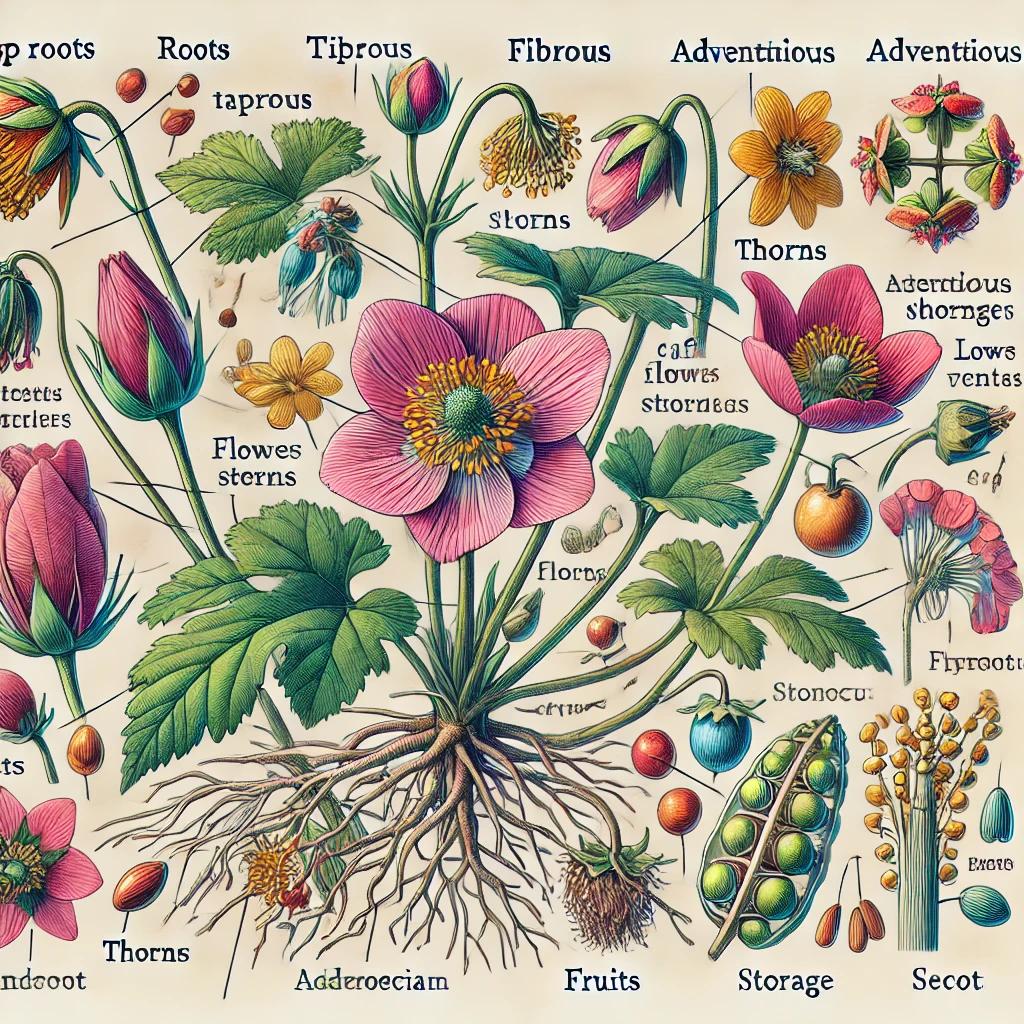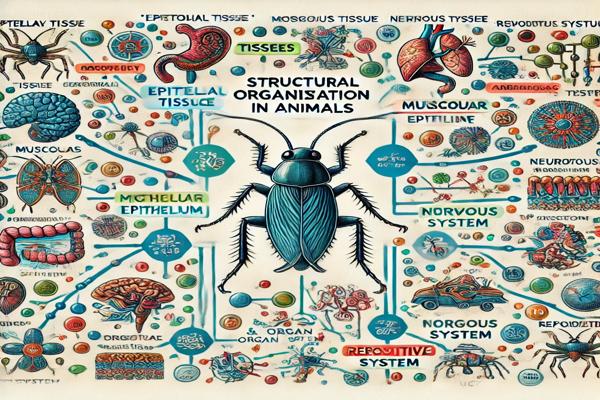Anatomy of Flowering Plants

The anatomy of flowering plants is a detailed study of their internal structure, encompassing tissues, tissue systems, and secondary growth. It provides insights into how plants are structured and how their organs function and adapt to various environments. Understanding plant anatomy aids in taxonomy, physiology, and agricultural science.
Tissues in Flowering Plants
Tissues are groups of similar cells that work together to perform specific functions in a plant. They are broadly classified into meristematic tissues and permanent tissues.
Meristematic Tissues
Meristematic tissues consist of actively dividing cells and are responsible for the growth of plants. These tissues are found in specific regions such as the tips of roots and shoots.
Characteristics of Meristematic Tissues
- Thin cell walls.
- No intercellular spaces.
- Abundant cytoplasm.
- Cells retain the ability to divide.
Classification of Meristematic Tissues
- Based on Position:
- Apical Meristem: Found at the tips of roots and shoots; responsible for primary growth (increase in length).
- Lateral Meristem: Found along the sides of stems and roots; responsible for secondary growth (increase in girth).
- Intercalary Meristem: Located between mature tissues; facilitates regrowth in grasses and other monocots.
- Based on Origin:
- Promeristem: Found in the embryo and seedling stage.
- Primary Meristem: Arises from promeristem; contributes to primary growth.
- Secondary Meristem: Develops from permanent tissues and is responsible for secondary growth.
Permanent Tissues
When meristematic tissues mature, they lose their ability to divide and become specialized in structure and function. These are termed permanent tissues.
Types of Permanent Tissues
I. Simple Permanent Tissues
- Parenchyma:
- Structure: Cells are isodiametric, spherical, oval, or polygonal with thin cellulose walls and intercellular spaces.
- Function: Photosynthesis, storage, and secretion.
- Examples: Found in the cortex and pith of stems and roots.
- Collenchyma:
- Structure: Cells have thickened corners due to pectin and cellulose; intercellular spaces are absent.
- Function: Provides mechanical support and flexibility.
- Examples: Found below the epidermis in stems and petioles.
- Sclerenchyma:
- Structure: Dead cells with lignified walls; includes fibres and sclereids.
- Function: Provides mechanical support.
- Examples: Found in seed coats, nut shells, and vascular tissues.
II. Complex Permanent Tissues
- Xylem (Conducts water and minerals):
- Tracheids: Dead, elongated cells with lignified walls; main water-conducting element in gymnosperms.
- Vessels: Long cylindrical structures with lignified walls and large lumens.
- Xylem Fibres: Provide structural support.
- Xylem Parenchyma: Stores food and helps in lateral conduction.
- Phloem (Transports food):
- Sieve Tubes: Long tube-like cells with sieve plates.
- Companion Cells: Associated with sieve tubes; help maintain a pressure gradient.
- Phloem Parenchyma: Stores food.
- Phloem Fibres: Provide mechanical support.
Tissue Systems in Plants
Plant tissues are organized into three main systems based on their functions:
- Epidermal Tissue System:
- Outermost protective layer of the plant.
- Includes:
- Cuticle: Waxy layer that prevents water loss.
- Stomata: Pores for gas exchange, surrounded by guard cells.
- Trichomes: Hair-like structures on stems and leaves; may secrete oils.
- Root Hairs: Single-celled structures that increase the surface area for water absorption.
- Ground Tissue System:
- Comprises all tissues except epidermal and vascular tissues.
- Includes parenchyma, collenchyma, and sclerenchyma.
- Functions: Photosynthesis, storage, and support.
- Vascular Tissue System:
- Consists of xylem and phloem.
- Forms vascular bundles, which are classified as:
- Radial: Xylem and phloem arranged alternately (in roots).
- Conjoint Open: Xylem and phloem together with cambium (in dicot stems).
- Conjoint Closed: No cambium present (in monocot stems).
Anatomy of Dicotyledonous and Monocotyledonous Plants
1. Dicotyledonous Root
- Epidermis: Outer layer with root hairs.
- Cortex: Parenchymatous cells with intercellular spaces.
- Endodermis: Inner layer with suberized Casparian strips.
- Pericycle: Produces lateral roots.
- Vascular Bundles: Radial arrangement with a cambium ring.
- Pith: Small or absent.
2. Monocotyledonous Root
- Epidermis: Outer protective layer.
- Cortex: Parenchymatous cells.
- Vascular Bundles: Polyarch (many xylem and phloem bundles).
- Pith: Large.
- No secondary growth due to the absence of cambium.
3. Dicotyledonous Stem
- Epidermis: Covered with a cuticle and trichomes.
- Cortex: Includes collenchyma and parenchyma.
- Vascular Bundles: Arranged in a ring, conjoint, open, and endarch (protoxylem towards the center).
- Pith: Prominent and parenchymatous.
4. Monocotyledonous Stem
- Epidermis: Covered with a cuticle.
- Hypodermis: Sclerenchymatous.
- Vascular Bundles: Scattered, conjoint, closed, and surrounded by bundle sheaths.
- Pith: Absent or indistinct.
5. Dicotyledonous Leaf (Dorsiventral)
- Epidermis: Adaxial (upper) and abaxial (lower) with more stomata on the lower side.
- Mesophyll: Differentiated into palisade and spongy parenchyma.
- Vascular Bundles: Reticulate venation with bundle sheath cells.
6. Monocotyledonous Leaf (Isobilateral)
- Epidermis: Stomata present on both surfaces.
- Mesophyll: Undifferentiated.
- Bulliform Cells: Present along the veins, helping in folding/unfolding of leaves.
- Vascular Bundles: Parallel venation.
Secondary Growth
Secondary growth refers to the increase in girth of stems and roots, mainly in dicots and gymnosperms.
Vascular Cambium
- Formation: Intrafascicular cambium and interfascicular cambium combine to form a cambial ring.
- Activity:
- Produces secondary xylem on the inner side and secondary phloem on the outer side.
- More xylem is produced, leading to a woodier structure.
Annual Rings
- Spring Wood (Early Wood): Formed during favorable conditions; lighter and less dense.
- Autumn Wood (Late Wood): Formed during unfavorable conditions; darker and denser.
- Annual Ring: Combination of spring and autumn wood.
Heartwood and Sapwood
- Heartwood: Central, non-functional, highly lignified region; provides mechanical support.
- Sapwood: Peripheral, functional region; conducts water and minerals.
Cork Cambium
- Develops from the cortical region.
- Produces:
- Phellum (Cork): Outer protective layer.
- Phelloderm (Secondary Cortex): Inner layer.
- Lenticels: Lens-shaped openings for gas exchange.
Secondary Growth in Roots
- Occurs in dicots and gymnosperms, but not in monocots.
- Cambium Formation: A wavy cambial ring is formed initially, which later becomes circular.
- Produces secondary xylem and phloem, similar to stems.
Conclusion
The anatomy of flowering plants provides an understanding of their structural adaptations and functional organization. This knowledge is crucial for plant classification, improving agricultural practices, and studying ecological interactions. By exploring the tissues, tissue systems, and growth patterns, we gain deeper insights into the fascinating world of angiosperms.
Read also
- Plant Anatomy – Britannica
- NCERT Textbook on Anatomy of Flowering Plants
- Detailed Plant Anatomy – Biology Discussion
- Plant Anatomy Topics – ScienceDirect
- Springer Reference on Plant Anatomy
- Coursera Course on Anatomy of Flowering Plants
- Khan Academy: Anatomy of Flowering Plants
Hi, I’m Hamid Ali, an MSc in Biotechnology and a passionate Lecturer of Biology with over 11 years of teaching experience. I have dedicated my career to making complex biological concepts accessible and engaging for students and readers alike.
Beyond the classroom, I’m an avid blogger, sharing insights, educational resources, and my love for science to inspire lifelong learning. When I’m not teaching or writing, I enjoy exploring new advancements in biotechnology and contributing to meaningful discussions in the scientific community.
Thank you for visiting my blog! Feel free to connect and explore more of my work.




